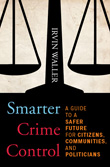My new book on Smarter Crime Control uses the evidence on what are effective ways to reduce violent crime to propose an agenda for action to cut violence by 50% and save taxpayers billions – in the USA $100 billion a year.
Current rates of murder, traffic fatalities, drug overdoses, and incarceration are unacceptable in 2014. We have the knowledge and best practices to make them history and reduce the waste of taxes on what has not worked. The book organizes the knowledge to show how to retool policing, improve corrections, and make criminal courts more preventive. It confirms ways to help youth in problem neighborhoods start on a path that does not lead to chronic offending, gang violence, and incarceration. It proposes promising ways to stop violence against women and fatalities on the roads. It shows how cities can take charge of making their neighborhoods safer for less. It is written as A guide to a safer future for citizens, communities, and politicians.
In 2013, there were many encouraging signs that leading politicians were getting smarter on crime control – at least in the USA. The most comprehensive so far was the US Attorney General´s speech to the American Bar Association on Smart Crime Control, which admitted their over use of mass incarceration, racial bias in criminal justice policies, need to use crime prevention knowledge, the shame of sexual assault on campuses, and much more.
But there were many others that resonate with the evidence in Smarter Crime Control …
• The Chicago Tribune editorialized that a city´s violence level is a choice, including that its reduction is more than policing.
• President Obama announced a federal effort to increase pre-school education because $1 invested saved $7, in part savings in costs of crime.
• New York City proudly showed that it had cut its use of incarceration by 50% in the last ten years, while its crime rates declined.
• The New Jim Crow was in the New York Times best seller list, demonstrating that over-use of incarceration for blacks resonated with a broad group of book readers.
• The Sentencing Project realized that the much heralded tinkering with alternatives to incarceration as in Texas would take 88 years to achieve any reduction in incarceration to levels of the 1970´s.
• The White House declared that it would invest in ¨life skills training¨ to prevent teenagers drifting into alcohol and other drug abuse, because it saved $18 for every $1 invested.
• Colorado and Washington (and Uruguay) got closer to implementing their frameworks to sell marijuana not just for medical but also for recreational purposes.
But much more is needed with the USA known among affluent democracies to have the highest rates of homicide, traffic fatalities and drug overdoses. The U.S. has more projects proven to prevent violence than the rest of the world put together. It has the most data on its over-use of incarceration and its failure to prevent violence. Its legislators have access to pioneering data banks on cost effective ways to reduce crime.
We have a wealth of (as yet unused) knowledge on effective violence prevention that we did not have fifty years ago. Yes, smart investing in young men and parenting in ¨problem places¨ will produce healthy citizens less prone to violence. Yes, we can stop gun violence in cities. Yes, we can help men to treat women without sexual abuse. Yes, we can do more to reduce traffic fatalities. Yes, we can abandon the use of incarceration where its costs do not justify the reduction of harm, such as for marijuana use. Yes, we can stop wasting lives and dollars on punishment, when prevention is so much more cost effective.
The key to sensible policy is shifting the debate from the disadvantages of reactive policing and hyper-incarceration to what stops violence before it happens on the streets and against women, as well as what is just and fair, while saving taxes big time.
The beginnings of a shift to smart on crime are encouraging, but this book calls for a shift from the outdated criminal justice paradigm that is failing, racially biased, and exorbitant to an effective, modern, fair and lean system for safer communities that spares victims from the loss and pain of preventable violence. – http://bit.ly/1av9GHF.

